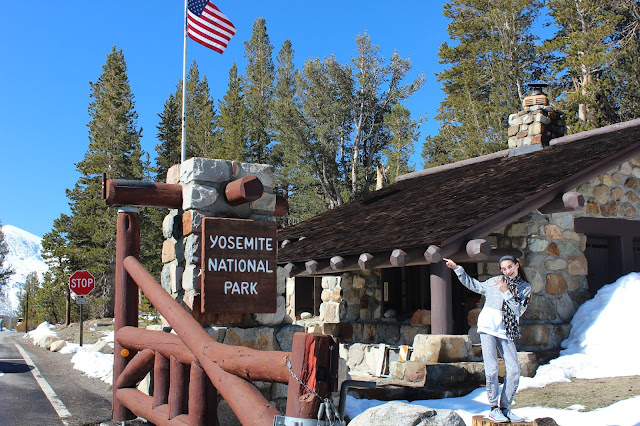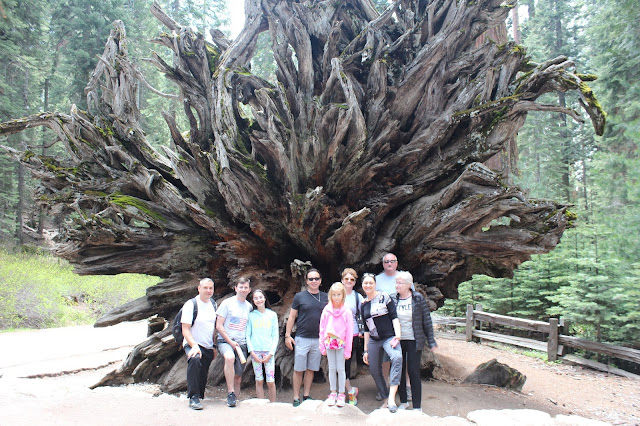 If the mercury climbed to 90+ Fahrenheit the previous day in
Death Valley, the following morning “winter gear” was required as we woke up to
about 40F (that’s roughly 7 Celsius).
But with the sun quickly out in full force, melting the last remnants of
snow along Tioga Pass (which typically does not open until very late April or
early May), it made the 2 hour drive from almost 10,000 feet at the top, to
4,000 feet in the valley, a memorable experience. Pictures and videos can’t do it justice. They can capture the mirror-like surface of a
lake, reflecting the upside-down image of the trees on the far shore, but can’t
fully convey the intense tranquility of the place, the serenity of it all, the wind softly whistling through the trees, the water lazily lapping against the shore, or
the crisp, natural perfume in the morning air as spring brings everything back to life.
If the mercury climbed to 90+ Fahrenheit the previous day in
Death Valley, the following morning “winter gear” was required as we woke up to
about 40F (that’s roughly 7 Celsius).
But with the sun quickly out in full force, melting the last remnants of
snow along Tioga Pass (which typically does not open until very late April or
early May), it made the 2 hour drive from almost 10,000 feet at the top, to
4,000 feet in the valley, a memorable experience. Pictures and videos can’t do it justice. They can capture the mirror-like surface of a
lake, reflecting the upside-down image of the trees on the far shore, but can’t
fully convey the intense tranquility of the place, the serenity of it all, the wind softly whistling through the trees, the water lazily lapping against the shore, or
the crisp, natural perfume in the morning air as spring brings everything back to life.There are many stops along the way to allow for ample gawking. Oooohs and aaaahs. Instincts want to keep you rooted in place for a long while, just to take it all in. But the same instincts pull you away, driven by the curiosity of seeing what lies around the next bend in the road. All equally breathtaking, by the way!
Lembert Dome, the Tuolomne Meadows, and especially Olmsted
Point are some of the obligatory stops along the way. The first glimpse of the valley from the
latter gives you an initial appreciation of how glorious this place is! And how vast.
 |
| This guy chased after us the entire trip! |
As Hwy 120 (Tioga Pass) winds down over the last few miles, you make it through the last tunnel and the traffic gets to an almost complete halt, as everyone stops to take in the full valley view. That, and plenty of pictures.
Unfortunately – and I’m sure being Memorial Day weekend had plenty to do with it – the traffic never moves at more than 10-20 mph beyond this point. And with limited parking in the valley, it all becomes a very frustrating affair. The local shuttles circling the valley every 10-15 minutes do help, but all the traffic seems to somehow distract from the natural beauty of all these surroundings...
El Capitan is imposing.
Massive. As if standing guard at
the entrance to the valley. A giant, towering
granite wall shooting out of the ground.
Straight up! Depending of time of
day, the sun’s rays paint glorious hues of red, orange and yellow across its
vertical surface. And if you’re lucky,
you might spot one or two daredevils who insist on getting to the top the hard
way.
On the opposite side, Bridalveil Falls is in full force, as the snow is melting, generating the extra volume and the deafening roar of the water hurtling down the cliffside. Ditto for the Upper and Lower Yosemite Falls. Or any other of the smaller waterfalls around the valley. They say late spring is the best time to enjoy the waterfalls, all at full volume. But I would imagine any time of the year would offer a unique perspective of this wonderful scenery. It’s simply amazing. And surrounding the valley, El Capitan, Cathedral Rocks, Glacier Point, Sentinel Dome, and far in the distance, Half Dome stand tall as if taking in the whole glory below…
 |
| The Ahwahnee back yard |

Next day, we headed to Glacier Point trying to get there before the crowds. Astonishing panoramic views, but I think sunset from this vintage point would be even better, as the sun would hit it from the opposite end.
Again, pictures can only capture small jigsaw puzzle pieces of this phenomenal scenery. But not the vastness of it all, or its perpetual movement, or the faint roar of the waterfalls in the distance, nor the trill and twitter of birds piercing through the morning crisp air.
Glacier point is definitely an obligatory stop in the park. As one approaches the edge, and the valley below opens up in all its splendor, thoughts around how small we are [in the grand scheme of things] materialize almost instantly. And without realizing it, one is immediately lost in meditation, breathless almost, inadvertently storing this complex 3D picture in a corner of the mind labeled "permanent". Oh, and for those looking to hike it up (they claim this is the best hike in the park) put aside about 3-4 hours each way, and bring plenty of water!
For more Yosemite superlatives, less than an hour south – near the Wawona gate – the Mariposa Grove has close to 500 giant sequoias, most of them older than 1,000 years, some even around for 2-3 millennia. There are several of these giants near the parking lot, but for the full experience I recommend walking the 2+ mile trail to the “museum” and the lower Grove. You won’t regret it. At the end of that trek, the Fallen Tunnel Tree (roughly 2,300 years old) is quite a sight to behold (and proof that man meddling with nature is not always the best thing [structurally weakened by the hole in its base, the tree collapsed under its own weight during a heavy storm in 1969])
 |
| Today... and in 1962 and 1918 below... |
The sheer enormity of these giants is humbling. Standing next to it, a human is absolutely dwarfed. The “extreme” is The Grizzly Giant – whose girth is more than 90 feet (27 meters) with a diameter at the base of almost 30 feet (9 meters). Those numbers don’t say much, but the pictures below tell the whole story… I really felt Lilliputian standing next to these giants.
 |
| under the Grizzly Giant |
“Delicate” or not, most of them have been around for a very
long time. Way before Columbus
“discovered” these lands. Way before the
world started on the journey towards “civilization”. Some are even older than Christ! And for that reason – in order to restore the
grove’s dynamic ecology and increase its resilience – this section of the park
is currently closed (until spring of 2017).
So if this little write-up and attached pictures sparked an interest,
you’ll have to plan beyond that date…
Frankly, that wait would definitely be worth it. Personally, this is already in my “top 10” travel experiences (and I’ve been around a bit)! Next time will definitely extend the Yosemite stay, and spend more time on the trails…
For now, off to the next destination: a quick tour of NapaValley (link)
Links to the rest of the itinerary:
* * * * *
Links to the rest of the itinerary:
- Death Valley
- Napa Valley
- San Francisco
- Pacific Coast Hwy (from SF to LA)
- Los Angeles
- San Diego
- Grand Canyon West & Hoover Dam
- Las Vegas


























































No comments:
Post a Comment